| |
|

NOW-SUNDAY, SEPTEMBER 7

SUNDAY, AUGUST 24
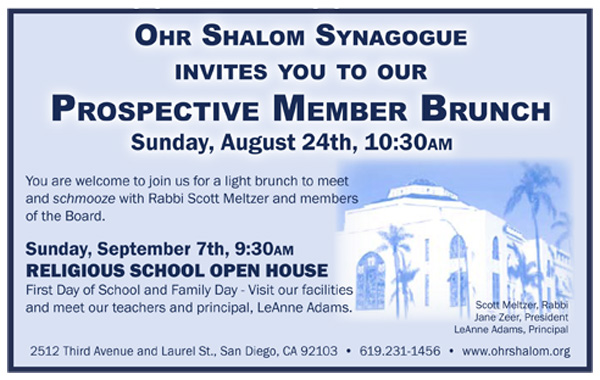
MONDAY, SEPTEMBER 1

SUNDAY, SEPTEMBER 7 Ner Tamid Open House/ Barbecue
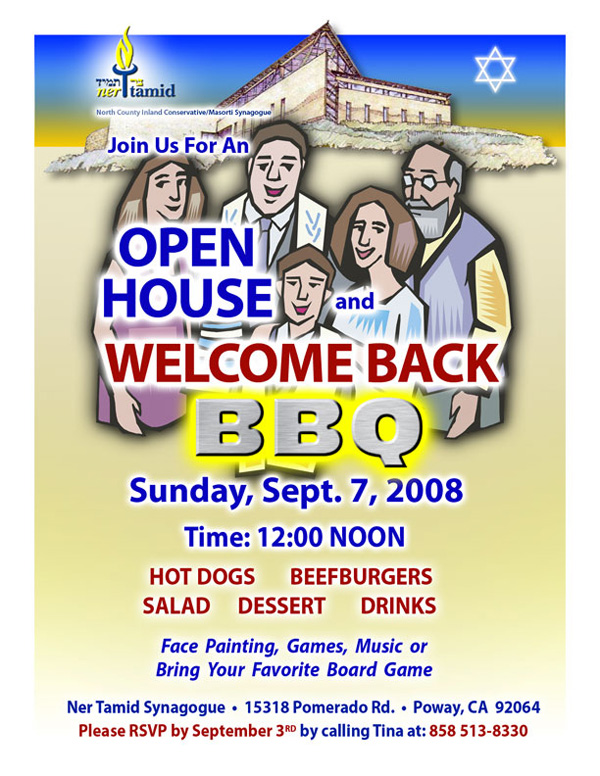
.
FRIDAY, SEPTEMBER 12, 2008 Temple Solel S'more Shabbat
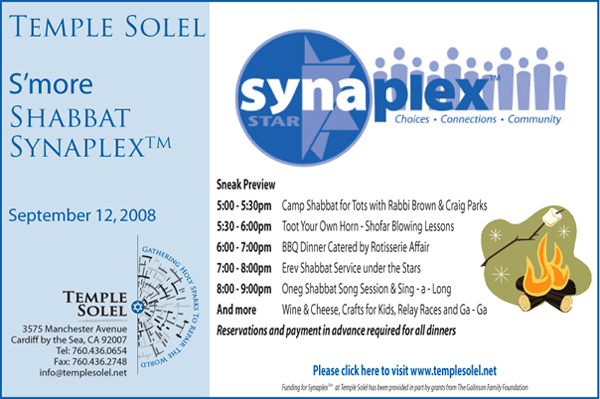
________________________________________________________
MON., SEPT. 29-THURS., OCT. 9



.jpg)
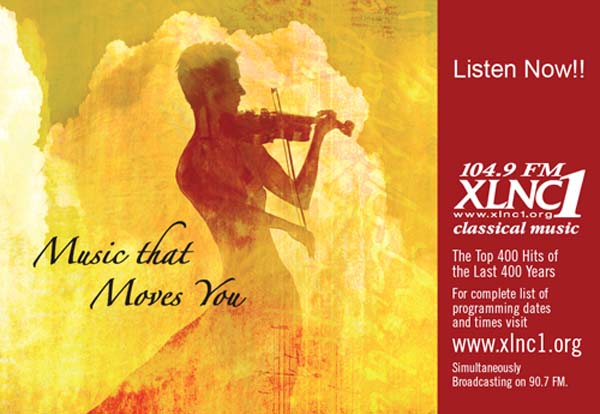

l.
.


THE JEWISH CITIZEN
Paul Spector, hospital roommate, served
as an international problem-solver
By Donald H. Harrison
 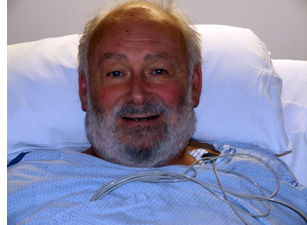 SAN DIEGO—I waved goodbye to my hospital roommate, Paul Spector (at right), yesterday, but not before I had interviewed him on his career as an educational innovator who had helped the U.S. Marine Corps with its race relations program, assisted five nations in Asia with their primary school education programs, fostered community development in Ecuador, and even aided Israel in understanding its problem of traffic casualties. SAN DIEGO—I waved goodbye to my hospital roommate, Paul Spector (at right), yesterday, but not before I had interviewed him on his career as an educational innovator who had helped the U.S. Marine Corps with its race relations program, assisted five nations in Asia with their primary school education programs, fostered community development in Ecuador, and even aided Israel in understanding its problem of traffic casualties.
Spector, 80, seems to be recovering nicely from an episode of sudden chest pains that he thought signaled a heart attack , but may in fact have been a gall bladder problem. Like me, he had been receiving a battery of diagnostic tests at Kaiser Permanente Hospital, and also like me he prefers schmoozing with his fellow patients to watching the television sets that stare down from the walls of every patient room. Unlike me, he is remaining a while longer at Kaiser, while I was released on the sixth day after I began treatment for a bacterial infection, which doctors believe may have been brought on by germs from my mouth penetrating my blood stream during a "deep cleaning" session at the dentist’s. I will fight the infection with a four-week run of antibiotics.
Spector, who holds a PhD in psychology, worked for the American Institutes for Research in Washington, D.C., and later in his career was the founder and president of the Institute for International Research.
In 1969, Spector’s company was retained by the Marine Corps to develop a course on race relations that could defuse tensions between black and white Marines. He and a team led by Robert L. Humphrey began by meeting separately with black and white Marines and asking them to indicate their grievances with each other. Typically blacks said that they were discriminated against and looked down upon, as if they were a slave class, while whites said that the blacks seemed hostile and physically threatening. The overwhelming majority of both groups indicated that if the other’s behavior changed, they believed they could work together. However, about 10 percent of each group were people whose attitudes were so hardened, they didn’t want to get along. “These were the haters,” Spector said.
The team next began guided discussions with both sets of Marines. They told a story about American soldiers who saw villagers in Turkey with sores on their faces, and rags on their bodies. “These people have no reason to live,” one soldier commented. “If you think that is so, take out your knife and try to kill one of them,” sugggested the sergeant. No one took up the suggestion, however, the soldiers immediately understood that the villagers would defend themselves.
The team next spoke about the commonalities of all humanity, about how all humans have emotions but also have reason, how people want the best for themselves and for their children, and how in societies human beings seek to protect themselves with laws regulating aggressive behavior. In democracies, the team reminded the Marines, people have a voice about what those laws should say.
Spector said the guided discussions then had Marines imagine themselves faced with the situations that had caused members of the other group to complain. Many agreed that they would feel the same way, or take the same action, if they were in the same situation as their adversaries.
At no point did the program ever call for the two sides to trade recriminations, which would have been counter-productive, Spector said. Rather the program emphasized that both sides are part of the same society, which as Marines they were sworn to honor and to defend.
Over the years, the race relations course which began at Marine Corps Recruit Depot in San Diego was expanded to become a human relations course, in which not only issues of race but also issues of gender and ethnicity were confronted. Eventually, the program was moved to Quantico, Virginia, and structured so that every 2nd lieutenant in the Marine Corps took the course and was able to teach its principles to incoming classes of enlisted men and women.
The lessons learned through the Marine Corps program were put to work in various school districts where racial tensions had soared as a result of involuntary bussing programs to achieve integration, Spector said.
For the Asian nations of the Philippines, Singapore, Indonesia, South Vietnam and Thailand, Spector’s company was asked to devise programs that could improve children’s learning, notwithstanding the fact that these countries in many cases had fewer than one teacher per 200 students.
The response was a program in which adult volunteers and older children could learn as they go, and by following a highly structured format, could become teachers to younger children. Sixth graders taught 1st graders, 5th graders taught 2nd graders, and 4th graders taught 3rd graders from materials prepared in step-by-step fashion by educational experts.
Spector said the difference became quite apparent between schools that had the system and those which did not. “In one, kids were noisy, excited, and there was a hubbub; in the other the schools were dull, quiet,” and untouched by the excitement of learning.
Community development in Ecuador was a dual-purpose project: to teach new skills and health practices to villagers, while at the same time testing what modes of communication are most effective as agents for change.
In widely separated villages, opportunities were presented for the residents to equip their huts with smokeless stoves, for women to utilize a local berry in the production of a marmalade, for people to be vaccinated against smallpox, and for the construction of latrines. To some villages, information about these projects were broadcast as part of radio programs that also included music, comedies and dramas. In other villages, the information was made available through lectures and demonstrations. In still others, only printed information was made available.
“In radio villages, they chose mostly to make marmalade (jam) and to be vaccinated against smallpox,” Spector said, whereas “in face-to-face villages, they chose more often to build latrines and install smokeless stoves.” The difference, he suggested, was that the “face-to-face villages “ chose projects that could be demonstrated in person, but which were more difficult to describe over the radio. The projects chosen by the radio villages were easier for people to imagine.
At the request of the Israeli government, Spector went to Israel in 1968 to see if he could shed some insight on Israel’s devastatingly high death rate on the highways. Through research, he found some interesting contributing factors to the highway mayhem.
Leyland Trucks, a British company familiar with driving conditions in Israel, identified the paucity of street signage and other road cosmetics such as lane markings as an important factor in the highway carnage. People looking for the name of a street would slow suddenly on the highway, and be slammed into by an inattentive driver, Spector explained.
But the problem ran far deeper, he said. “The pedestrian population were not used to vehicles, nor did they understand the impact of being struck by a vehicle,” Spector said. “Most people had never driven cars. The European Jews, displaced Jews, hadn’t grown up with cars,” he said.
The Israeli government, considering cars to be the province of the wealthy and thus anti-Socialist, put very high duties on imported cars, making them twice as expensive to buy in Israel in the United States. Additionally the government required drivers to demonstrate their ability to
conduct the vehicle and to maintain it.
The anti-automobile policies didn’t staunch the demand for cars, but it did have an impact on other buying decisions. Instead of signing up for full driver-education courses, many Israelis contented themselves with learning how to start, steer and stop the cars. They didn’t want to pay for such other course subjects as defensive driving, the rules of the road, and safety practices. And instead of studying good driving practices, new Israeli drivers instead spent time learning the parts of an engine.
Spector’s team calculated the cost of traffic accidents to Israel—including hospitalization, lost work time, repairs, and the like—and concluded that the financially strapped Jewish state was spending more money on road accidents than on purchasing its entire fleet of Phantom jets, deemed necessary for defense purposes.
Presenting its findings to the Israeli government, Spector’s group urged the government to reduce duties on cars, to conduct a large-scale public information campaign on the necessity to drive properly, and to save money by instituting a national no-fault insurance program. The recommendations, especially the one dealing with a public information campaign, were partially implemented. No-fault insurance on the other hand was a non-starter. “Do they have it in New York?” asked one official. “No,” replied Spector. Then forget about it, was the official’s message.
Today, Spector is semi-retired and divides his time between homes in La Jolla and in Bethesda, Maryland.


Calling all Judaica artists

ADVENTURES IN SAN DIEGO JEWISH HISTORY
Editor's Note: To create a permanent and accessible archive, we are reprinting news articles that appeared in back issues of various San Diego Jewish newspapers. You may access an index of the headlines of those articles by clicking here. You may also use the Google search program on our home page or on the headline index page to search for keywords or names.
Tifereth Israel Men’s Club
From Southwestern Jewish Press, December 2, 1949, page 5
The next meeting of the Tifereth Israel Men’s Club, which will be held on Tuesday evening December 6th in the synagogue at 8:00 p.m. will be in the form of a social meeting for members and their wives.
The highlight of the evening will be a talk by Mr. Maxwell Kaufman, publisher of the Southwestern Jewish Press. Mr. Kaufman, who recently returned from a to and a half years stay in Europe, where he was an Area director for the Joint Distribution Committee, working with Displaced Persons, will speak on some of his European experiences. A question and answer period will follow.
A soial hour will then follow with cards and mah jongg the order of the evening. Guests are asked to provide their own cards and mah jongg sets.
An able committee will serve a delicious Buffet Supper to top the evening.
Beth Jacob Congregation
From Southwestern Jewish Press, December 2, 1949, page 5
Congregation Beth Jacob will hold their regular monthly meeting on Tuesday evening, December 6th at Beth Jacob Center, 3206 Myrtle Street.
A. Abramson, president, will call the meeting to order promptly at 8:00 p.m. and following committee reports, will take up the business of the evening.
The ratification of the Constitution is the most important piece of business that evening, and all members are urged to be present to help in this vital matter.
Morrie Kraus, Chairman of the Building Committee, will report on the progress of the Building Campaign and discussion will be held on the date for the groundbreaking ceremony for the new building of the Synagogue and Center.
Refreshments will be served at the close of the meeting.
Tifereth Israel Elects Officers
From Southwestern Jewish Press, December 2, 1949, page 5
The Tifereth Israel Synagogue held its annual election of Officers on Thursday, Nov. 18.
The following were elected to office: Alex J. Newman, President; Moe S. Berlin, 1st Vice President; Its Penter, 2nd Vice Pres.; Henry Bowman, Rec. Secretary; Edward Baranov, Financial Sec; Moe Hershey, Treasurer.
The following were elected to the Board of Directors for a period of two years: I Teacher, Sam Addleson, Paul Nestor, Abe Ratner, Ben Levenson, Isadore Jacobson, Sidney Newman, Joe Spatz and Moss Addleson.
Elected or a term of one year: Milo Berenson, Sam Druskin, Herman Tulchinsky, Max Zemen, Marco Ratner, Sam Geller, Frank Pomeranz, Sid Naliboff, Al Young, Irving Schneider, Maurce Sahalsky, Abe Sackheim, Sidney Smith, Irving Goodman, Max Brody, Mrs. Its Penter.
Arrangements for a joint installation ceremony with the Daughters of Israel are being made now. The date for this event will be announced in the near future.
Tifereth Israel Sisterhood
From Southwestern Jewish Press, December 2, 1949, page 6
The Tifereth Israel Sisterhood extends an invitation to the congregations and their friends to participate in the Jewish Home Beautiful Pageant, on December 13th, at 7:30 p.m. at the Tifereth Israel Synagogue.
The Jewish Home Beautiful Pageant is to symbolize the proverb, “The Wisdom of Women Buildeth the Home.” Together with the Father, the Mother created the sanctuary which has been the Jewish pride through all the ages, the Jewish Home Beautiful.
This sanctuary to beautify God elevates the household tasks to the dignity of sacred rites upon a holy altar. By performing the Mitzvo, with the lighting of the candles, with the Lulav, the Esrog and with a fine Sukkos, the Jewish character of the Home Is created. The Jewish atmosphere then gives the faith, love and understanding which permeates family relationships.
The Sisterhood’s celebration of the Chanukah festival is presented to urge every Mother to assume her role as an artist, and on every festival, Sabbath and Holiday, to make her home and her family table a thing of beauty.
In charge of the program are Mrs. Abe Ratner and Mrs. Monreo Levens, co-chairmen, assisted by Mesdames Earl Brodie, Its Penter, Alex Newman and Harry Mallen.
Narrator for the program is Mrs. A.P. Nasatir, with table hostesses as follows: Rosh Hashanah, Mrs. Sam Brenes; Yom Kippur, Mrs. Rod Horrow; Sukkot, Mrs. Woodrow Ratner; Chanukah, Mrs. Sol Chenkin; Purim, Mrs. Herman Tulchinsky; Passover, Mrs. Milo Bereneson; Shabuous, Mrs. Eddie Cantor, and Shabbat, Mrs. Max Gardner.
Traditional Chanukah dishes (latkes and apple sauce) will be served by MRs. Herman Sarfan, Chairman and Mrs. Edward Sarfan, co-Chairman, assisted by Mesdames Irving Krasner, Moe Hershey, Irving Goodman, Same Sosna, I. Teacher, Paul Nestor, Edward Goldstein, Eddie Addleson, Abe Sackheim, Harry Snyder, Sam Sklar, Al DeSure, Sam Fischer, Wm Moss and Mrs. Marian Goldfarb.
The entire decorations for the affair will be directed by Mrs. Zel Greenberg.
{Return to top}


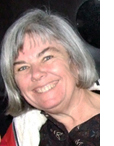 Nancy Harrison Nancy Harrison
cruise & tour specialist
(619) 265-0808
.

.


SAN DIEGO JEWISH WORLD THE WEEK IN REVIEW
Arts
SDSU professors probe common origins, traditions of Christianity and Judaism by Fred Reiss in Winchester, California
Thursdays With the Songs of Hal Wingard:
—#45, Love Is The Promise
—#95, Love Is So Elusive
—#174, Porcelain Love
San Diego History
'Adventures' column provides overview of San Diego's Jewish community in late 1940s by Donald H. Harrison in San Diego
Adventures in San Diego Jewish History; articles from the archives
—December 2, 1949: Who's New?
—December 2, 1949: J.C.R.A. by Jeanne Camiel
—December 2, 1949: San Diego Lasker Lodge B’nai B’rith
—December 2, 1949: Temple Men’s Club
International
Former American, now an Israeli, finds faults with both Obama and McCain by Ira Sharkansky in Jerusalem
Former captive nations want to be in NATO by Shoshana Bryen in Washington, D.C.
The Jews Down Under, a roundup of Australian Jewish news by Garry Fabian
—Israeli, Aussie paramedics share knowledge
—High honour for Australian community leader
—Australian Government denies policy shift on Israel
—Maccabi provides Jewish sporting and social networks
—Security concerns about latest technology
—Toben awaits verdict
—Gold Coast school shuts its doors
—Professionals providing community support
—The Promised Land Down Under
—Vorchheimer settles civil claim against authorities
—The Keeper of Memories
Adventures in San Diego Jewish History
—November 18, 1949: American Jewish Congress
—November 18, 1949: Cottage of Israel
—December 2, 1949:Mordecai Kaplan To Be Honored in Los Angeles
—December 2, 1949:Agency Authorizes Fund Campaigns
—December 2, 1949: Beth Jacob P.T.A.
San Diego
Jewish stories at the foot of a hospital bed by Donald H. Harrison in San Diego
Letters
Touching the Soul author touched by review, letter from Max Fallek
Adventures in San Diego Jewish History
—November 18, 1949: Temple Senior League
—November 18, 1949: Temple Beth Israel P.T.A.
—November 18, 1949: Bankruptcy faces Israel, declares Christian minister
—November 18, 1949:Hadassah
—November 18, 1949: Junior Pioneer Women
—November 18, 1949: Temple Beth Israel
International
'Best school in Israel' a matter of survival for planned Sha'ar Hanegev High School by Ulla Hadar in Sha'ar Hanegev, Israel.
San Diego
Why ducks are wary—but not necessarily intimidated—by those human critters by Sheila Orysiek in San Diego
Arts
Surviving and transforming in widowhood, book review by Donald H. Harrison in San Diego
Adventures in San Diego Jewish History
--November 18, 1949: Plans Country Fair For Temple Sisterhood
--November 18, 1949: San Diego Birdie Stodel Chapter B’nai B’rith
--November 18, 1949:Addleson Calls Meeting For Home
--November 18, 1949: 35th Anniversary Observed by Jolly 16
--November 18, 1949:Tifereth Israel Sisterhood
-November 18, 1949: Hadassah Study Group
International
A second- generation scholar promotes food's peace-building possibilities by Donald H. Harrison in San Diego
Judaism
A place to start teshuvah by Rabbi Leonard Rosenthal in San Diego
Sports
A bissel sports trivia by Bruce Lowitt in Clearwater, Florida
Letters
Ginsburg, Maccabi security committee showed high community commitment, from Stuart Simmons in San Diego
Adventures in San Diego Jewish History
—November 18, 1949: Congregation Beth Jacob
—November 18, 1949: S.D. Lasker Lodge
—November 18, 1949:San Diego Hebrew Home for the Aged Auxiliary
—November 18, 1949:Jewish War Veterans Auxiliary
—November 18, 1949: Beth Jacob Ladies Auxiliary
International
Russian-Georgian conflict reverberates through Israel; chills its FSU relations by Ira Sharkansky in Jerusalem
So where was Russian expert Condy Rice before the bombs started falling? by Shoshana Bryen in Washington D.C.
Sports
JCC Maccabi Games tennis results, compiled by the Lawrence Family JCC
Arts
The kind of friend all may value by Donald H. Harrison in San Diego
Thoughts on writing a bimonthly column by Natasha Josefowitz in La Jolla, California
Conclusion of Reluctant Martyr, a serialization of a historical novel by Sheila Orysiek.
Adventures in San Diego Jewish History
—November 18, 1949:Israel Faces Bankruptcy! {Editorial}
—November 18, 1949: Overseas News and Views by Maxwell Kaufman
—November 18, 1949:Who’s New? (Maybe They Came From Your Home Town)
—November 18, 1949:Weinbergers Hit Half Century Mark
Link to previous editions
< BACK TO TOP
Copyright 2007-2008 - San Diego Jewish World, San Diego, California. All rights reserved. |
|

